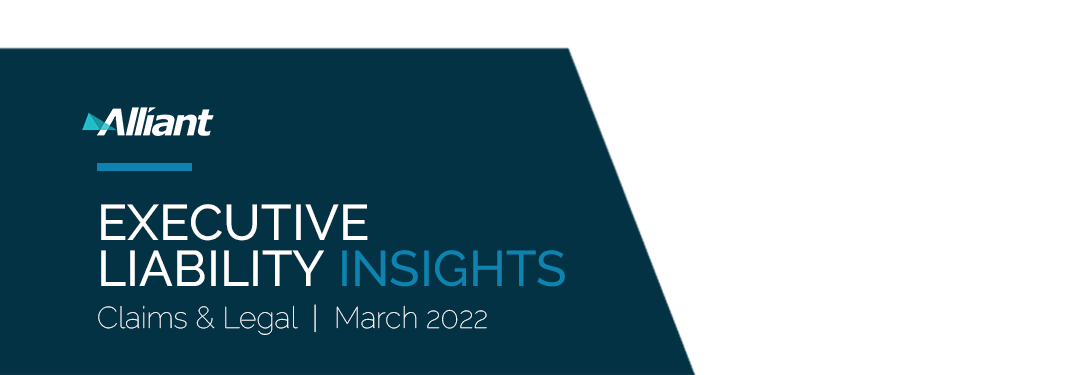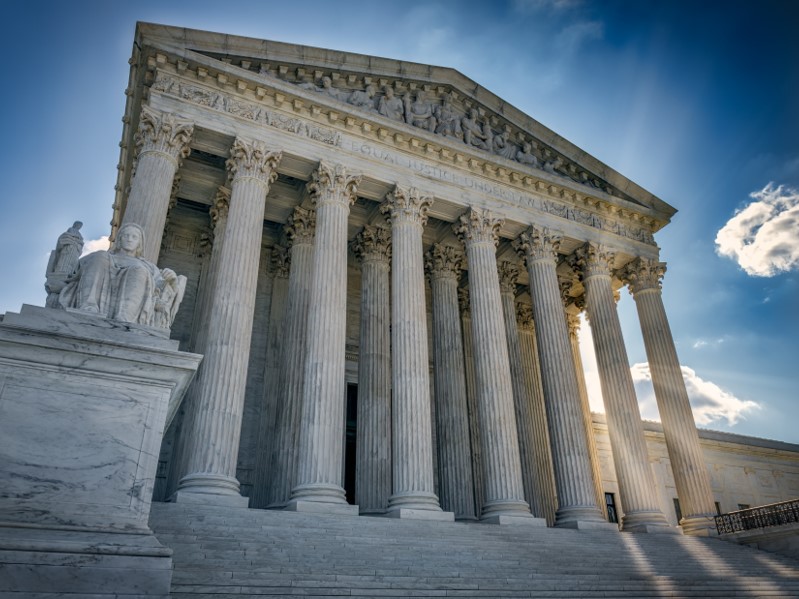
Navigating today’s complex risk environment can be a monumental task. Steve Shappell, Alliant Claims & Legal, spearheads Executive Liability Insights, a monthly review of news, legal developments and information on executive liability, cyber risk, employment practices liability, class action trends and more.
Table of Contents
DELAWARE GENERAL CORPORATION LAW AMENDED TO AUTHORIZE USE OF CAPTIVE INSURANCE FOR D&O COVERAGE
Delaware’s governor recently signed a bill amending the Delaware General Corporation Law (“DGCL”) to expressly authorize Delaware corporations to purchase and maintain directors and officers liability (“D&O”) insurance by or through captive insurance companies.
Read More >>
CONTRACT EXCLUSION IN D&O POLICY PRECLUDES COVERAGE FOR EMPLOYMENT SUIT
TriPacific Cap. Advisors, LLC. v. Fed. Ins. Co., No. SACV 21-919 JVS, (C.D. Cal. Jan 28, 2022)
This coverage dispute arose after an employee filed suit against his former employer, a financial services company, alleging breach of contract, breach of fiduciary duties, and failure to pay earned wages.
Read More >>
TEXAS SUPREME COURT ESTABLISHES EXCEPTION TO EIGHT-CORNERS RULE
In insurance law, the “eight-corners rule” provides that a liability insurer's duty to defend its insured be assessed by reviewing the claims asserted in the plaintiff's complaint, without reference to matters outside the four corners of the complaint plus the four corners of the policy.
Read More >>
WRONGFUL DEATH SUIT TRIGGERS D&O INSURER’S DUTY TO DEFEND BECAUSE OF INCONGRUITY BETWEEN EXCLUSIONS
Roadway Servs., Inc. v. Travelers Cas. & Sur. Co. of Am., No. 3:20-cv-02777-JGC (N.D. Ohio Jan. 6, 2022)
After an employee of a road construction company was struck and killed by a car while working as part of a paving project, the employee’s wife filed a wrongful death lawsuit against the company for creating a dangerous work environment and failing to put in place adequate safety controls.
Read More >>
DELAWARE CHANCERY COURT RELIES ON BUSINESS JUDGMENT RULE IN DISMISSING HIGH PROFILE MERGER OBJECTION SUIT
Galindo and Walsh v. Stover, et al. No. 2021-0031 (Del. Ch. Jan. 26, 2022)
After two high profile energy companies announced a multibillion-dollar stock for stock merger, shareholders of the target company filed a lawsuit against the company’s board of directors challenging the merger.
Read More >>
FRAUDULENT BANK TRANSFER SCHEME CLAIM RESURRECTED UNDER CRIME POLICY
Ernst & Haas Mgmt. Co., Inc. v. Hiscox, Inc., No. 20-56212 (9th Circ. Jan. 26, 2022)
A real estate firm’s accounts payable clerk received several emails purporting to be from her supervisor instructing her to pay multiple invoices.
Read More >>
NEVADA SUPREME COURT SAYS INSUREDS HAVE BURDEN TO PROVE EXCEPTION TO POLICY EXCLUSION
Zurich Am. Ins. Co. v. Ironshore Specialty Ins. Co., 497 P.3d 625 No. 81428 (Nev. 2021)
The question of who bears the burden of proof to exclusions and exceptions to exclusions comes up often in coverage litigation, and this recent decision by the Nevada Supreme Court highlights the contentious issues.
Read More >>
CYBER CORNER
Click to read the following cases:
- DHS LAUNCHES FIRST-EVER CYBER SAFETY REVIEW BOARD
Read More >>
EPL CORNER
Click to read the following case:
- CALIFORNIA SUPREME COURT SAYS STATUTE IS STANDARD TO FOLLOW IN WHISTLEBLOWER RETALIATION CLAIMS
- ENTERTAINMENT COMPANY DOES NOT OWE SEVERANCE DESPITE AMBIGUOUS DEFINITION IN PLAN DOCUMENT
Read More >>
SEC CORNER
Click to read the following cases:
- SEC ANNOUNCES PROPOSED CYBER RULES UNDER ADVISERS AND INVESTMENT COMPANY ACTS
- SEC SEEKS FASTER INVESTOR DISCLOSURE TO PUBLIC
Read More >>
SHAREHOLDER CORNER
FEBRUARY 2022 SECURITIES CLASS ACTION FILINGS
Read More >>
DELAWARE GENERAL CORPORATION LAW AMENDED TO AUTHORIZE USE OF CAPTIVE INSURANCE FOR D&O COVERAGE
Delaware’s governor recently signed a bill amending the Delaware General Corporation Law (“DGCL”) to expressly authorize Delaware corporations to purchase and maintain directors and officers liability (“D&O”) insurance by or through captive insurance companies.
This amendment permits coverage for liabilities incurred by a corporation’s directors, officers, employees, and agents, even in certain situations where the corporation would not be permitted to indemnify for such liability.
Section 145 of DGCL governs a Delaware corporation’s indemnification of covered persons. Under Section 145(a), a corporation may indemnify covered persons in connection with third party claims. Section 145(b) authorizes a corporation to indemnify against claims brought by or in the right of the corporation (derivative claims); however, the corporation cannot indemnify against judgments or amounts paid in settlement in such derivative cases. The new legislation does not alter this significant limitation under Delaware law, which, unlike numerous other jurisdictions, permits indemnification for derivative settlements and judgments. Until the amendment to Section 145(g), it was not clear to what extent this section applied to captive insurance.
Like traditional D&O insurance, this new amendment to DGCL allows for captive insurance to provide coverage for liabilities incurred by covered persons for, among other things, judgments, fines, and settlement amounts paid for claims brought by or in the right of the corporation. However, a significant question remains as to the use of a captive in the event of the bankruptcy of the parent company. Specifically, it is unclear whether a captive would be available to indemnify a director or officer when the company has filed for Chapter 7 or Chapter 11 bankruptcy, or if the assets of the captive will be made available to satisfy the obligations of the parent company.
Additionally, the amendment includes narrow limitations on the use of captive insurance. Under DGCL Section 145(g)(1), a captive policy must exclude from coverage—and must provide that the captive insurer may not make a payment in connection with losses attributable to personal profit or financial advantage to which the covered person was not entitled—deliberate criminal or fraudulent acts or any knowing violation of law. It bears noting that the language in traditional D&O policies (and Side A policies in particular) arguably provides broader protection for directors and officers than the standard embedded in DGCL Section 145(g)(1). Additionally, the changes to Section 145(g) do not apply to any limitations that the U.S. Securities and Exchange Commission (“SEC”) may impose on indemnification, nor do they permit the use of a captive to indemnify a director or officer for conduct that the SEC has specifically stated would not be indemnifiable.
Finally, there are some practical considerations corporations must weigh before entertaining the use of a captive for their D&O insurance. A corporation must be ready, willing, and able to capitalize, operate, and manage a fully licensed insurance company. Operating a captive is an expensive and time-consuming endeavor and will need to be regulated in the relevant jurisdictions. Furthermore, given that the issues surrounding indemnification have yet to be tested in a court of law, it remains to be seen whether directors and officers will be comfortable with the use of a captive insurance arrangement.

CONTRACT EXCLUSION IN D&O POLICY PRECLUDES COVERAGE FOR EMPLOYMENT SUIT
TriPacific Cap. Advisors, LLC. v. Fed. Ins. Co., No. SACV 21-919 JVS, (C.D. Cal. Jan 28, 2022)
This coverage dispute arose after an employee filed suit against his former employer, a financial services company, alleging breach of contract, breach of fiduciary duties, and failure to pay earned wages.
According to the employee, the terms of his employment, including salary and bonus, were set forth in a revised employment agreement that arose out of an earlier oral agreement he had reached with the company’s president. The company tendered the suit under its directors and officers liability (“D&O”) policy, but the insurer declined to cover the claim, citing the policy’s exclusion for breaches of contract. Under the contract exclusion, coverage was precluded “for Loss on account of any Claim … based upon arising from, or in consequence of any Insured’s liability under any contract or agreement regardless of whether such liability is direct or assumed.”
In the ensuing coverage litigation, the company argued the insurer had a duty to defend the breach of fiduciary duty claim because, as a matter of law, such claims cannot arise from liability under an employment agreement since employers do not owe fiduciary duties to employees. Furthermore, the company claimed the former employee did not allege that any fiduciary duties arose out of the employment agreement. Accordingly, because there was potential coverage for the fiduciary duty claim, the insurer was obligated to provide a defense for the entirety of the underlying action.
The insurer, on the other hand, contended that all the former employee’s claims, including the breach of fiduciary duty claim, were “based upon, arising from, or in consequence of” the company’s liability under the employment agreement, and therefore no coverage was available. While recognizing that a claim could arise under an employment dispute and not be out of liability under a contract, the court nevertheless sided with the insurer, finding the contract exclusion precluded coverage because the employment dispute arose from the revised employment agreement. The court also noted that absent the employment agreements, no liability would exist. According to the court, “the relationship between the claims and the agreement constitute[d] the 'minimal causal connection' necessary to be considered as 'arising from' the contractual liability owed,” and as such, the insurer had no duty to defend the company.

The Takeaway
Broad exclusionary language can needlessly limit or preclude coverage. To avoid a coverage dispute like that in which this insured found itself embroiled, it is critical to narrow “arising out of” causation language wherever possible, which will help ensure an exclusion applies only to direct claims. Limiting an exclusion’s applicability to specific instances or individuals, as well as carvebacks for reimbursement of defense costs, should also be considered.
TEXAS SUPREME COURT ESTABLISHES EXCEPTION TO EIGHT-CORNERS RULE

In insurance law, the “eight-corners rule” provides that a liability insurer's duty to defend its insured be assessed by reviewing the claims asserted in the plaintiff's complaint, without reference to matters outside the four corners of the complaint plus the four corners of the policy. In two recent decisions, the Texas Supreme Court outlined the limited parameters under which Texas courts may find exception to the eight-corners rule.
- BITCO General Ins. Corp.
- Pharr-San Juan-Alamo Indep. Sch. Dist.
The Takeaway
Although the above cases are specific to insurance coverage law in the state of Texas, most states defer to the eight-corners rule when it comes to the use of extrinsic evidence in proving or negating a duty to defend. As such, it is important to understand when and where an exception to the eight-corners rule could be considered, as other jurisdictions may look to these rulings as persuasive authority.
WRONGFUL DEATH SUIT TRIGGERS D&O INSURER’S DUTY TO DEFEND BECAUSE OF INCONGRUITY BETWEEN EXCLUSIONS
Roadway Servs., Inc. v. Travelers Cas. & Sur. Co. of Am., No. 3:20-cv-02777-JGC (N.D. Ohio Jan. 6, 2022)

After an employee of a road construction company was struck and killed by a car while working as part of a paving project, the employee’s wife filed a wrongful death lawsuit against the company for creating a dangerous work environment and failing to put in place adequate safety controls.
The construction company tendered the suit under its directors and officers liability (“D&O”) insurance policy, but the insurer denied coverage, citing the policy’s bodily injury exclusion and an exclusion for employment-related wrongful acts. Coverage litigation ensued.
The D&O policy’s bodily injury exclusion precluded coverage “for any Claim for any bodily injury, sickness, disease, death, loss of consortium, emotional distress, mental anguish, humiliation, loss of reputation, libel, slander, oral or written publication of defamatory or disparaging material, or invasion of privacy.” However, there was a carveback to the exclusion that gave back coverage for “any Claim for emotional distress, mental anguish, or humiliation with respect to any employment related Wrongful Act.” The insurer asserted that the term “Claim” should be equated to a cause of action and that a reference to damages for mental anguish was insufficient to trigger the carveback, but the court rejected the insurer’s argument, finding the wrongful death suit fell within the carveback because it alleged mental anguish as part of the damages sought in connection with an “employment related Wrongful Act.”
The policy also contained an exclusion precluding coverage “for any Claim [against the Company] based upon or arising out of any employment related Wrongful Act.” The court found that although this exclusion appeared on its face to apply to the wrongful death suit, it was inconsistent with the carveback in the bodily injury exclusion, which stated that “Claims” alleging mental anguish with respect to “employment related Wrongful Acts” would be covered. Given this “discrepancy,” the court held there was at least potential coverage for the suit, and therefore the D&O insurer had a duty to defend the construction company.
DELAWARE CHANCERY COURT RELIES ON BUSINESS JUDGMENT RULE IN DISMISSING HIGH PROFILE MERGER OBJECTION SUIT
Galindo and Walsh v. Stover, et al. No. 2021-0031 (Del. Ch. Jan. 26, 2022)

After two high profile energy companies announced a multibillion-dollar stock for stock merger, shareholders of the target company filed a lawsuit against the company’s board of directors challenging the merger.
The shareholders alleged they were not “fully informed” with respect to the proposal because they had not been advised of a preliminary rival proposal that was made two years prior to the announced deal. Additionally, the merger price and process were unfair due to conflicts of interest by key management level officers, according to the shareholders.
The board members argued the rival proposal (for a partial sale of the company) was never more than a preliminary expression of interest, and as such, was not material information necessary for the shareholders to make an informed, non-coerced decision on the subject merger. Thus, the board members argued they had no duty to disclose the potential partial sale.
Finding that none of the omitted information was material because the earlier proposal was never entertained by management or the board, the Delaware Chancery Court concluded it was not required to be disclosed in the merger proxy. In so finding, the court held that the stock merger was approved by a fully informed, uncoerced majority of disinterested stockholders, and therefore the business judgment rule applied to the transaction. Accordingly, the court dismissed the complaint and did not address the breach of fiduciary duty allegations.
The Takeaway
When a suit alleges a corporation's directors violated their duty of care to the company, courts will evaluate the case based on the business judgment rule, which presumes the directors acted in good faith and used appropriate procedures. Unless directors have clearly violated the law or acted against the interests of the company and its stakeholders, courts will uphold their decisions. As we see in the case at hand, Delaware courts give great deference to the decisions of boards of directors under the business judgment rule.
FRAUDULENT BANK TRANSFER SCHEME CLAIM RESURRECTED UNDER CRIME POLICY
Ernst & Haas Mgmt. Co., Inc. v. Hiscox, Inc., No. 20-56212 (9th Circ. Jan. 26, 2022)

A real estate firm’s accounts payable clerk received several emails purporting to be from her supervisor instructing her to pay multiple invoices.
Although the clerk authorized the payments, the emails were in fact initiated by a fraudster as part of a duplicitous scheme. By the time the clerk became suspicious, the funds had already been transferred and could not be recovered.
The company subsequently submitted a claim to recover the funds under its commercial crime policy. Although the policy provided coverage for “computer fraud” and “funds transfer fraud,” the insurer declined to cover the claim. Since the company’s own employee had initiated the wire transfer, the insurer maintained that the loss did not “result directly” from the fraudulent activity, which was required to trigger coverage under the policy. Thereafter, coverage litigation ensued.
In reversing a lower court’s decision, the Ninth Circuit Court of Appeals disagreed with the insurer’s argument. According to the court, the loss did result directly from computer fraud because there was no intervening event, and the loss was the direct result of the clerk’s actions pursuant to the fraudulent instructions. The court further found the matter satisfied the funds transfer fraud provision of the policy. Specifically, the email to the clerk directing her to transfer funds to the perpetrator should have been construed as a direct instruction to the bank, the court noted, because it was done with the sole purpose of initiating the wire transfer. Otherwise, the policy’s fraudulent instruction definition, which contemplated an instruction sent to the insured before the bank, would have been superfluous.
The Takeaway
Fraudulent instruction schemes are all too common. In addition to understanding whether—and to what extent—coverage is available under any commercial crime coverage, to maximize recovery should the inevitable occur, companies should also be aware of any potential coverage available under a cyber liability policy.
NEVADA SUPREME COURT SAYS INSUREDS HAVE BURDEN TO PROVE EXCEPTION TO POLICY EXCLUSION
Zurich Am. Ins. Co. v. Ironshore Specialty Ins. Co., 497 P.3d 625 No. 81428 (Nev. 2021)

The question of who bears the burden of proof to exclusions and exceptions to exclusions comes up often in coverage litigation, and this recent decision by the Nevada Supreme Court highlights the contentious issues.
In the underlying actions, two federal district courts issued conflicting decisions regarding whether, in Nevada, the insured or the insurer has the burden of proving that an exception to an exclusion of coverage provision applies. Both cases were appealed to the Ninth Circuit Court of Appeals, which certified the following questions to this court: 1) whether, under Nevada law, the burden of proving the applicability of an exception to an exclusion of coverage in an insurance policy falls on the insurer or the insured; and 2) whichever party bears such a burden, may it rely on evidence extrinsic to the complaint to carry its burden, and if so, is it limited to extrinsic evidence available at the time the insured tendered the defense of the lawsuit to the insurer?
The Nevada Supreme Court concluded that the burden of proving the applicability of an exception to an exclusion for coverage in an insurance policy falls on the insured. The court also concluded the insured may rely on any extrinsic evidence that was available to the insurer at the time the insured tendered the defense to the insurer.
In holding the burden is on the insured, not the insurer, to prove the potential that an exception to an exclusion applies when determining whether the insurer owes a duty to defend, the Nevada Supreme Court reviewed the law around the country and adopted the majority rule. The court recognized that although most states have adopted this approach, some of them have adopted it specifically in the context of determining the duty to indemnify. Indeed, the duty to defend arises when there is a potential for coverage, whereas the duty to indemnify arises when the insured's activity and the resulting damage falls within the policy's coverage. The court recognized that the burden is on the insured to prove the duty to indemnify, as well as the duty to defend, but emphasized that in so ruling, its intention was not to erode the duty to defend by heightening the insured's burden of proof. The weight of proof needed to fulfill the burden of proving a duty to defend is lighter than the duty to indemnify, the court reiterated, noting only the potential for coverage must be proven.
On the issue of use of extrinsic evidence, the court stated that an insurer “bears a duty to defend its insured whenever it ascertains facts which give rise to the potential of liability under the policy,” and that under Nevada law, an insured may present such extrinsic facts to the insurer—and rely upon them—to argue that the insurer owes a duty to defend as within an exception to an exclusion. Looking to California law, the court noted that “since the duty to defend must be determined at the outset of litigation based upon the complaint and any other facts available to the insurer, we hold that the insured may use extrinsic facts that were available to the insurer at the time it tendered its defense to prove there was a potential for coverage under the policy and, therefore, a duty to defend.”
Cyber Corner
DHS LAUNCHES FIRST-EVER CYBER SAFETY REVIEW BOARD
The Department of Homeland Security (“DHS”) recently announced the formation of a new regulatory body known as the Cyber Safety Review Board (“CSRB”).
CALIFORNIA SUPREME COURT SAYS STATUTE IS STANDARD TO FOLLOW IN WHISTLEBLOWER RETALIATION CLAIMS
Lawson v. PPG Architectural Finishes, Inc., No. S266001 (Cal. Jan. 27, 2022)
This matter arose after an employee of a paint and coatings manufacturer alleged he was directed by his manager to engage in unethical behavior in the course and scope of his employment.
ENTERTAINMENT COMPANY DOES NOT OWE SEVERANCE DESPITE AMBIGUOUS DEFINITION IN PLAN DOCUMENT
Soto v. Disney Severance Pay Plan, et al., No. 20-4081 (2nd Cir. Feb. 16, 2022)
This matter arose when an employee of an entertainment company was terminated after a stroke left her unable to work.
SEC Corner
SEC ANNOUNCES PROPOSED CYBER RULES UNDER ADVISERS AND INVESTMENT COMPANY ACTS
The U.S. Securities and Exchange Commission (“SEC”) recently announced proposed rules to address cyber risks under the Investment Advisers Act and the Investment Company Act.
SEC SEEKS FASTER INVESTOR DISCLOSURE TO PUBLIC
February 2022 Noteworthy Enforcement Actions Filed
|
Director/Officer |
Role |
Company |
|
Charles Strongo |
CEO, CFO |
Global Wholehealth Partners Corp. |
|
James Velissaris |
Chief Investment Officer |
Infinity Q Capital Management |
February 2022 Noteworthy Settlements and Judgments
|
Amount |
Director/Officer |
Role |
Company |
|
$1,392,000.00 |
Martin Shkreli |
CEO |
Retrophin, Inc. |
Source: U.S. Securities and Exchange Commission
Shareholder Corner
FEBRUARY 2022 SECURITIES CLASS ACTION FILINGS
Acutus Medical, Inc.
Source: Stanford Law School Securities Class Action Clearinghouse
ABOUT ALLIANT INSURANCE SERVICES
Alliant Insurance Services is the nation’s leading specialty broker. In the face of increasing complexity, our approach is simple: hire the best people and invest extensively in the industries and clients we serve. We operate through national platforms to all specialties. We draw upon our resources from across the country, regardless of where the resource is located.
Contributors

Abbe Darr, Esq.
Claims Attorney
abbe.darr@alliant.com
David Finz, Esq.
Claims Attorney
david.finz@alliant.com
Jacqueline Noster, Esq.
Claims Attorney
jacqueline.noster@alliant.com
Jacqueline Vinar, Esq.
Claims Attorney
jacqueline.vinar@alliant.com
Jaimi Berliner, Esq.
Claims Attorney
jaimi.berliner@alliant.com
Katherine Puthota
Claims Advocate
katherine.puthota@alliant.com
Matia Marks, Esq.
Claims Attorney
matia.marks@alliant.com
Meaghan Fisher
Senior Claims Advocate
meaghan.fisher@alliant.com
Megan Padgett
Senior Claims Advocate
megan.padgett@alliant.com
Robert Aratingi
Senior Claims Advocate
robert.aratingi@alliant.com
Robert Hershkowitz, Esq.
Claims Attorney
robert.hershkowitz@alliant.com
Steve Levine, Esq.
Claims Attorney
slevine@alliant.com
Vanessa Gonzalez
Senior Claims Advocate
vanessa.gonzalez@alliant.com